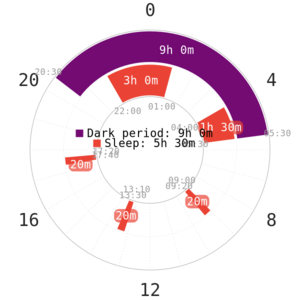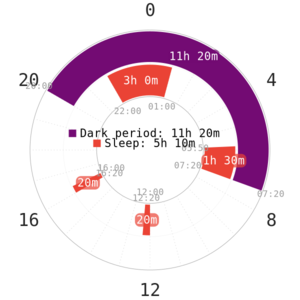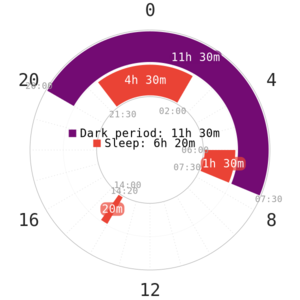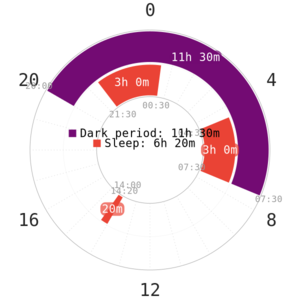Difference between revisions of "Ducamayl"
(Create new) |
m (Text replacement - "DUCamayl" to "Ducamayl") |
||
| (55 intermediate revisions by 4 users not shown) | |||
| Line 1: | Line 1: | ||
| − | |||
| − | |||
| − | + | {{TNT|Experimental Schedule}}{{TNT|Ducamayl}}This schedule is a higly flexible schedule derived from the [[Dual core]] schedules.<ref name="reddit" /> Similar to [[Sevamayl]], it evolves from adaptation to Dual core schedule such as [[DC2]] and [[DC3#Extended|DC3-extended]]. Unlike with flexed versions of those regular schedules, Ducamayl allows taking [[naps]] when tired throughout the day, with a varying number of naps and changes in core timings as well as lengths. | |
| − | |||
| − | |||
| − | |||
| − | |||
| − | |||
| − | |||
| − | The name | + | ==Origin== |
| + | The name Ducamayl stands for “Dual Core As Much As You Like”. It is one of the 4 “-AMAYL<nowiki>''</nowiki> flexible polyphasic schedules, the other ones being [[Spamayl]], [[Sevamayl]], and [[Camayl]]. | ||
| − | + | Until recently, there has only been one anecdotal success from sleeper [[Aethermind|Aethermind's]] father, who has been unintentionally maintaining the schedule for more than 20 years without signs of ill health. His schedule consists of 2 somewhat flexible core sleeps and between 1 and 2 naps in the day. | |
| − | + | First created and roughly drafted in 2017 in the [[Polyphasic sleep discord|Discord]], it was proposed as a flexible Dual Core counterpart to Sevamayl, a flexible [[Everyman]] schedule. In 2020, there have been two more recorded successful adaptations to Ducamayl, which are by [[GeneralNguyen]] and [[UncertainBeing]]. | |
| − | |||
| − | == | + | ==Mechanism== |
| − | + | The mechanism of Ducamayl is believed to resemble that of Sevamayl, with two shorter cores in place of the long Everyman core. | |
| − | + | As with all other Dual core schedules, the first core sleep provides mostly [[wikipedia:Slow-wave_sleep|SWS]] while the second core favors [[wikipedia:Rapid_eye_movement_sleep|REM]] sleep, with the nap(s) providing some REM and alertness boosts. Naps can be taken when alertness drops. | |
| − | |||
| − | + | After adapting to a rigid base Dual core schedule, the body gets used to the new sleep pattern, which involves 2 core sleeps and a number of naps, as well as the reduced total sleep. Then, the sleeper gradually adapts to [[flexing]], allowing naps to be moved, added, or removed. Because of 2 core sleeps covering much of the night and morning in which the alertness is the lowest, Ducamayl tends to have fewer [[naps]] than Sevamayl. | |
| − | == | + | ==Scheduling== |
| − | + | For average sleepers, the schedule would include at least ~4-5 hours of sleep from the two cores, with about 1-4 naps of 10-20 minutes in length. Nap spacing should take into account natural periods of tiredness, such as the early afternoon circadian dip. | |
| − | |||
| − | |||
| − | |||
| − | |||
| − | The | + | The wake gap between 2 cores can vary on a day-to-day basis. Each core might be flexed or changed in length to some extent. As with Sevamayl, it is not recommended to add or remove sleep cycles more than once a week, as either sleep debt or lengthening can destabilize the adaptation to the reduced total sleep. As with all other sleep schedules, should be at least 90-120 minutes awake between sleeps. |
| − | + | [[Dark period]] should be observed similar to other Dual core schedules, starting some time before the first core and ending after the second core. It is recommended to keep dark period consistent, even with the cores being flexed, to maintain a stable circadian rhythm and ensure sleep quality. | |
| − | + | Longer naps (30-40 minutes), even relatively late in the morning, are viable as long as the SWS is mostly accounted for by the cores. When necessary, it is also possible to schedule ultrashort naps (~10 minutes) if regular 20-minute nap are too long to schedule. In general, shorter naps contain much less REM. It is suggested that two 15-minute naps can replace one 20-minute nap, after accounting for the time it takes to fall asleep and reach REM. | |
| − | + | ==Adaptation== | |
| + | {{further|Flexing#-AMAYL}} | ||
| + | There has been some attempts at adapting to the schedule cold turkey, but they have virtually all failed. As with Sevamayl, first adapting to a strict Dual core base schedule seems to be necessary. The possible base schedules to start from include DC1, DC2, DC2-extended, as well as DC3-extended. | ||
| − | + | The process of adapting to Ducamayl from the rigid base schedule is similar to that of Sevamayl. First, one can start with [[flexing]] the naps slightly, such as by 30 minutes forward or back. Then, the cores can also be optionally flexed slightly. Over time, one can gradually increase the flexiblility windows of the sleeps. Finally, naps can be added or removed according to the level of tiredness one experiences in a given day. | |
| − | It is | + | It is important to do this gradually, however, as flexing all the sleeps right away can destabilise the adaptation. One or both cores of Ducamayl can remain fixed, instead focusing on the flexibility of naps for convenience in daily scheduling. |
| − | + | During and after the adaptation, some naps as well as cores may shorten. The best strategy is to get up as long as a good amount of sleep has already been gained since the schedule allows for extra naps later if you get tired. | |
| − | + | ==Difficulty== | |
| + | As Dual core schedules in general are often considered harder than their similar Everyman counterparts, adapting to this schedule may be somewhat more difficult compared to Sevamayl. As with other dual core schedules, this depends on whether one is a naturally segmented sleeper. | ||
| − | + | As with Sevamayl, the flexing adaptation will mostly consist of [[4-Stages Adaptation Model#Stage 4|Stage 4]]-like conditions, feeling somewhat refreshed most of the times, but not always. The adaptation is similarly considered to take several months to complete, in which one needs control of the sleeping environment to maintain the schedule. Overall, despite the relatively mild sleep deprivation, the adaptation to this schedule is considered hard. | |
| − | + | ==Lifestyle considerations== | |
| + | Like other “-AMAYL” schedules, people with irregular life schedules greatly benefits from Ducamayl. Similar to Sevamayl, Ducamayl is not very suitable for those on strict work schedules, since the ability to flex naps can be gradually lost if not regularly used. Compared to Sevamayl, Ducamayl generally requires fewer naps in the day, but involves a second core that may limit early morning activities. | ||
| − | The | + | Under emergency or social events, both cores sleeps can be delayed to allow more time awake in the evening. Alternatively, the first core may be skipped, and the second core may be extended by one cycle, though this would incur more sleep debt and be more destabilising. The [[dark period]] should change as little as possible to ensure a stable circadian rhythm. As a dual core schedule, however, it is inherently less accommodating to [[Circadian management#Late cores|late cores]], and those who needs to do this frequently are recommended to choose Sevamayl instead. |
| + | |||
| + | Dark period should be introduced some time before the first core and maintained in the wake gap between 2 cores like other Dual Core schedules. Because of the potential flexibility of cores, an experienced or well-adapted to flexing sleeper can start the first core 30m or 2-3h after dark period has begun whenever desired. However, this should not be done early in the adaptation, and too frequently afterwards, to avoid destabilising the schedule. | ||
| + | |||
| + | Nap timings should still take into account food and physical activity to ensure quality. With a flexible schedule like this, it may require more careful daily planning at all times. | ||
| + | |||
| + | It may be possible to occasionally extend either core sleep by one cycle to accommodate extra sleep needs, such as from heavy exercise or sickness, though this should not be done too often. As with all other reducing polyphasic schedules, significant oversleeps due to physical recovery, sickness, or substance use can destabilise the schedule, potentially undoing the adaptation. | ||
| + | |||
| + | ==Variants== | ||
| + | As with Sevamayl, Ducamayl can be derived from a range of base schedules. For average sleepers, at least 4-5 hours of time in cores is required to make the sleeps flexible, which would be around 5-6 hours of sleep in total. For this variant, DC2 and DC2-extended can be used as base schedules. The combinations of core lengths need not be standard; one of the two recorded attempts utilised a DC2 variant with two 2.5-hour cores. | ||
| + | |||
| + | People with reduced sleep needs may be able to transition to Ducamayl from either DC3 or Bimaxion, with about 3 hours of sleep in cores. One Discord user with reduced sleep needs successfully transitioned to this schedule from Bimaxion. However, these schedules are known to be exceedingly difficult to adapt to for average sleepers, and is unlikely to ever be flexible for them. | ||
| + | |||
| + | Alternatively, it is also possible to use a base schedule with 6 hours of sleep in cores. This variant would require fewer naps, with possibly some days without any nap at all, though it is debatable whether a Dual core schedule without naps on some days would qualify as Ducamayl. | ||
| + | |||
| + | <gallery mode="packed" widths="200" heights="200" caption="Ducamayl base schedules"> | ||
| + | File:DC3.png|DC3 ([https://napchart.com/smgnw chart]) | ||
| + | File:Bimaxion.png|Bimaxion ([https://napchart.com/fr1el chart]) | ||
| + | File:DC3-ext Base.png|DC3-extended ([https://napchart.com/fr1el chart]) | ||
| + | File:DC2 Base.png|DC2-extended ([https://napchart.com/fr1el chart]) | ||
| + | File:DC1-ext uneven.png|DC1-extended ([https://napchart.com/uxyo6 chart]) | ||
| + | File:DC1-ext even.png|DC1-extended ([https://napchart.com/6w0m6 chart]) | ||
| + | </gallery> | ||
| + | |||
| + | The characteristics of the base schedules still apply on Ducamayl. For example, variants with more total sleep time allows for more flexibility and is more tolerant to later cores, and those with longer first cores will provide SWS more effectively. | ||
| + | ==References == | ||
| + | {{reflist|refs= | ||
| + | <ref name="reddit">{{cite web |url=https://www.reddit.com/r/polyphasic/comments/jppeht/official_new_flexible_dual_core_polyphasic/ |title=OFFICIAL! New, Flexible Dual Core Polyphasic Pattern Released: Evolution of the Predecessor Segmented Sleep in the Modern Time |last=GeneralNguyen |website=Reddit |access-date=2020-11-19}}</ref> | ||
| + | }} | ||
| + | |||
| + | [[Category:Schedules]] | ||
| + | {{TNT|Polyphasic Sleep Schedules}} | ||
Latest revision as of 20:12, 9 January 2021
| Dual Core As Much As You Like | |
|---|---|
| chart link
Legend
| |
| Total sleep | Undefined, but may average around 5.5-6.5 hours |
| Proposed by | Polyphasic Sleep Discord Community |
| Difficulty | Hard |
| Specification | 2 cores, multiple short naps |
This schedule is a higly flexible schedule derived from the Dual core schedules.[1] Similar to Sevamayl, it evolves from adaptation to Dual core schedule such as DC2 and DC3-extended. Unlike with flexed versions of those regular schedules, Ducamayl allows taking naps when tired throughout the day, with a varying number of naps and changes in core timings as well as lengths.
Origin
The name Ducamayl stands for “Dual Core As Much As You Like”. It is one of the 4 “-AMAYL'' flexible polyphasic schedules, the other ones being Spamayl, Sevamayl, and Camayl.
Until recently, there has only been one anecdotal success from sleeper Aethermind's father, who has been unintentionally maintaining the schedule for more than 20 years without signs of ill health. His schedule consists of 2 somewhat flexible core sleeps and between 1 and 2 naps in the day.
First created and roughly drafted in 2017 in the Discord, it was proposed as a flexible Dual Core counterpart to Sevamayl, a flexible Everyman schedule. In 2020, there have been two more recorded successful adaptations to Ducamayl, which are by GeneralNguyen and UncertainBeing.
Mechanism
The mechanism of Ducamayl is believed to resemble that of Sevamayl, with two shorter cores in place of the long Everyman core.
As with all other Dual core schedules, the first core sleep provides mostly SWS while the second core favors REM sleep, with the nap(s) providing some REM and alertness boosts. Naps can be taken when alertness drops.
After adapting to a rigid base Dual core schedule, the body gets used to the new sleep pattern, which involves 2 core sleeps and a number of naps, as well as the reduced total sleep. Then, the sleeper gradually adapts to flexing, allowing naps to be moved, added, or removed. Because of 2 core sleeps covering much of the night and morning in which the alertness is the lowest, Ducamayl tends to have fewer naps than Sevamayl.
Scheduling
For average sleepers, the schedule would include at least ~4-5 hours of sleep from the two cores, with about 1-4 naps of 10-20 minutes in length. Nap spacing should take into account natural periods of tiredness, such as the early afternoon circadian dip.
The wake gap between 2 cores can vary on a day-to-day basis. Each core might be flexed or changed in length to some extent. As with Sevamayl, it is not recommended to add or remove sleep cycles more than once a week, as either sleep debt or lengthening can destabilize the adaptation to the reduced total sleep. As with all other sleep schedules, should be at least 90-120 minutes awake between sleeps.
Dark period should be observed similar to other Dual core schedules, starting some time before the first core and ending after the second core. It is recommended to keep dark period consistent, even with the cores being flexed, to maintain a stable circadian rhythm and ensure sleep quality.
Longer naps (30-40 minutes), even relatively late in the morning, are viable as long as the SWS is mostly accounted for by the cores. When necessary, it is also possible to schedule ultrashort naps (~10 minutes) if regular 20-minute nap are too long to schedule. In general, shorter naps contain much less REM. It is suggested that two 15-minute naps can replace one 20-minute nap, after accounting for the time it takes to fall asleep and reach REM.
Adaptation
There has been some attempts at adapting to the schedule cold turkey, but they have virtually all failed. As with Sevamayl, first adapting to a strict Dual core base schedule seems to be necessary. The possible base schedules to start from include DC1, DC2, DC2-extended, as well as DC3-extended.
The process of adapting to Ducamayl from the rigid base schedule is similar to that of Sevamayl. First, one can start with flexing the naps slightly, such as by 30 minutes forward or back. Then, the cores can also be optionally flexed slightly. Over time, one can gradually increase the flexiblility windows of the sleeps. Finally, naps can be added or removed according to the level of tiredness one experiences in a given day.
It is important to do this gradually, however, as flexing all the sleeps right away can destabilise the adaptation. One or both cores of Ducamayl can remain fixed, instead focusing on the flexibility of naps for convenience in daily scheduling.
During and after the adaptation, some naps as well as cores may shorten. The best strategy is to get up as long as a good amount of sleep has already been gained since the schedule allows for extra naps later if you get tired.
Difficulty
As Dual core schedules in general are often considered harder than their similar Everyman counterparts, adapting to this schedule may be somewhat more difficult compared to Sevamayl. As with other dual core schedules, this depends on whether one is a naturally segmented sleeper.
As with Sevamayl, the flexing adaptation will mostly consist of Stage 4-like conditions, feeling somewhat refreshed most of the times, but not always. The adaptation is similarly considered to take several months to complete, in which one needs control of the sleeping environment to maintain the schedule. Overall, despite the relatively mild sleep deprivation, the adaptation to this schedule is considered hard.
Lifestyle considerations
Like other “-AMAYL” schedules, people with irregular life schedules greatly benefits from Ducamayl. Similar to Sevamayl, Ducamayl is not very suitable for those on strict work schedules, since the ability to flex naps can be gradually lost if not regularly used. Compared to Sevamayl, Ducamayl generally requires fewer naps in the day, but involves a second core that may limit early morning activities.
Under emergency or social events, both cores sleeps can be delayed to allow more time awake in the evening. Alternatively, the first core may be skipped, and the second core may be extended by one cycle, though this would incur more sleep debt and be more destabilising. The dark period should change as little as possible to ensure a stable circadian rhythm. As a dual core schedule, however, it is inherently less accommodating to late cores, and those who needs to do this frequently are recommended to choose Sevamayl instead.
Dark period should be introduced some time before the first core and maintained in the wake gap between 2 cores like other Dual Core schedules. Because of the potential flexibility of cores, an experienced or well-adapted to flexing sleeper can start the first core 30m or 2-3h after dark period has begun whenever desired. However, this should not be done early in the adaptation, and too frequently afterwards, to avoid destabilising the schedule.
Nap timings should still take into account food and physical activity to ensure quality. With a flexible schedule like this, it may require more careful daily planning at all times.
It may be possible to occasionally extend either core sleep by one cycle to accommodate extra sleep needs, such as from heavy exercise or sickness, though this should not be done too often. As with all other reducing polyphasic schedules, significant oversleeps due to physical recovery, sickness, or substance use can destabilise the schedule, potentially undoing the adaptation.
Variants
As with Sevamayl, Ducamayl can be derived from a range of base schedules. For average sleepers, at least 4-5 hours of time in cores is required to make the sleeps flexible, which would be around 5-6 hours of sleep in total. For this variant, DC2 and DC2-extended can be used as base schedules. The combinations of core lengths need not be standard; one of the two recorded attempts utilised a DC2 variant with two 2.5-hour cores.
People with reduced sleep needs may be able to transition to Ducamayl from either DC3 or Bimaxion, with about 3 hours of sleep in cores. One Discord user with reduced sleep needs successfully transitioned to this schedule from Bimaxion. However, these schedules are known to be exceedingly difficult to adapt to for average sleepers, and is unlikely to ever be flexible for them.
Alternatively, it is also possible to use a base schedule with 6 hours of sleep in cores. This variant would require fewer naps, with possibly some days without any nap at all, though it is debatable whether a Dual core schedule without naps on some days would qualify as Ducamayl.
- Ducamayl base schedules
DC3 (chart)
Bimaxion (chart)
DC3-extended (chart)
DC2-extended (chart)
DC1-extended (chart)
DC1-extended (chart)
The characteristics of the base schedules still apply on Ducamayl. For example, variants with more total sleep time allows for more flexibility and is more tolerant to later cores, and those with longer first cores will provide SWS more effectively.
References
- ↑ GeneralNguyen. "OFFICIAL! New, Flexible Dual Core Polyphasic Pattern Released: Evolution of the Predecessor Segmented Sleep in the Modern Time". Reddit. Retrieved 2020-11-19.





